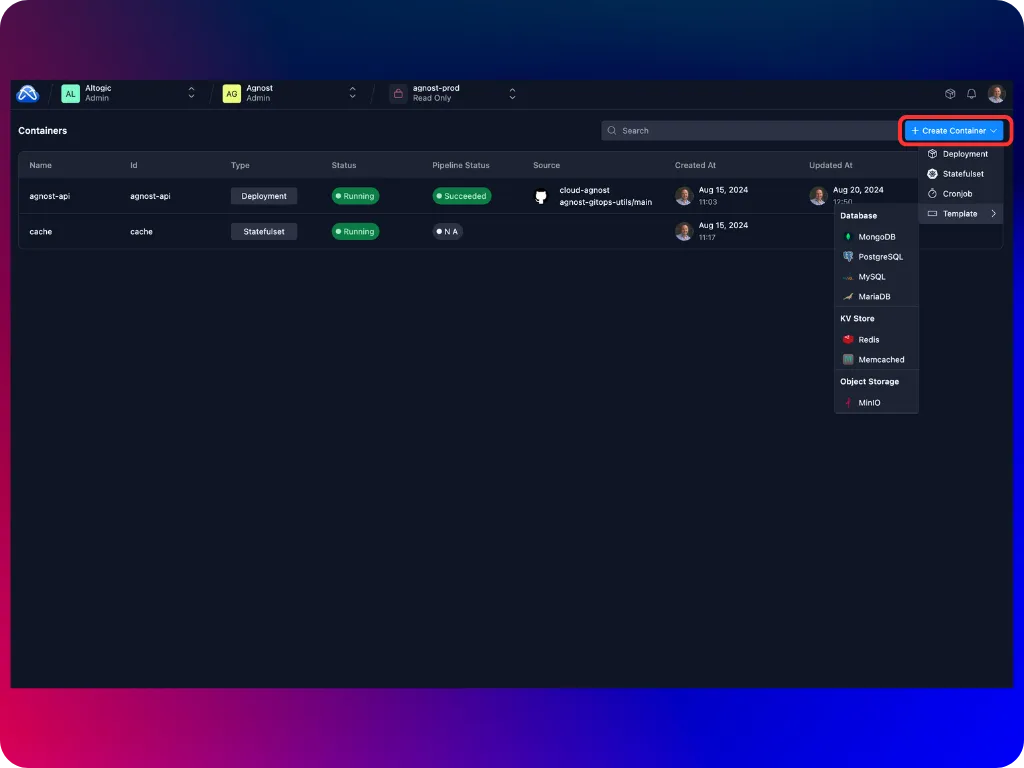Containers
A container can be a Kubernetes deployment, stateful set, or cron job. You create your containers in project environments, and an environment can host multiple containers. Agnost also provides a list of templates to use when creating your containers.
Deployments
Deployment is a higher-level abstraction that manages the deployment and scaling of a set of pods, typically running a single containerized application. A deployment provides declarative updates to applications, meaning you describe the desired state of your application (such as the number of replicas, the container image version, etc.), and Kubernetes ensures that the actual state matches your desired state over time.
- Deployments enable rolling updates, allowing you to update the application version or configuration without downtime. Kubernetes will gradually replace old pods with new ones, ensuring that the service remains available during the update process.
- Deployments allow you to quickly scale your application up or down by adjusting the number of replicas in the deployment configuration. You can easily specify the memory and CPU consumption rules to autoscale the number of pods managed by a deployment.
- Deployments can also self-heal. Kubernetes monitors the pods in a deployment. If a pod fails or becomes unresponsive, Kubernetes will automatically replace it to maintain the desired state. You can configure start-up, readiness, and liveness probes, which periodically check the heartbeat of your deployment pods.
- You can define detailed configuration parameters how the deployment should be created. The configuration parameters include the container image or connected git repository, environment variables, ports, ingress, TCP proxy, custom domain, and storage settings.
Stateful Sets
In Kubernetes, stateful sets manage the deployment and scaling of a set of pods and provide guarantees about the ordering and uniqueness of these pods. Like a deployment, a stateful set manages pods that are based on an identical container spec. Unlike a deployment, a stateful set maintains a sticky identity for each pod. These pods are created from the same spec but are not interchangeable: each has a persistent identifier maintained across rescheduling. Common use cases for stateful sets include databases, distributed file systems, and cache systems.
- Stable, Unique Pod Names: Each pod in a stateful set has a unique, stable name that is derived from the stateful set name and a sequential index (e.g., myapp-0, myapp-1). This allows for predictable network identities.
- Ordered, Graceful Deployment and Scaling: Pods in a stateful set are created, updated, and deleted in a specific order. This ensures that the application’s state remains consistent during scaling operations. For example, when scaling up, pods are created one at a time in sequential order (0, 1, 2, …). When scaling down, pods are deleted in reverse order.
- Stable Network Identities: Each pod in a stateful set has a consistent network identity that does not change over time, even if the pod is rescheduled to a different node. This is important for applications that require stable network identities, such as databases.
- Persistent Storage: Stateful set allows you to associate each pod with its own storage volume. These volumes are uniquely associated with the pods and persist beyond the life of individual pods. This means that when a pod is rescheduled, it retains access to its specific storage, which is critical for stateful applications.
Cron Jobs
A cron job creates jobs on a repeating schedule, and it is meant to perform regular scheduled actions such as backups, report generation, and so on. It runs a job periodically on a given schedule, written in cron format.
- Schedule: A cron job runs based on a schedule defined in a cron format. The schedule is specified using the cron syntax (* * * * *), where each field represents a time unit (minute, hour, day of month, month, day of week).
- Job Creation: At the specified times, the cron job controller creates a Kubernetes job object. Each job object creates one or more pods to run the specified task.
- Concurrency Policies: You can control how concurrent executions of the same task are handled with concurrency policies:
- Allow: Allows cron jobs to run concurrently, even if previous instances are still running.
- Forbid: Ensures that a new instance is not started if a previous instance is still running.
- Replace: Stops the currently running instance and starts a new one if a new execution is triggered.
- Time Zone: By default, the cron job schedule is based on the time zone of the Kubernetes master node, but you can specify a different time zone in Agnost Studio when creating or updating a cron job.
- Suspend: A cron job can be temporarily suspended to prevent new jobs from being created without deleting the cron job itself.
Creating New Containers
- To create a new container open the project and the environment where you would like to create it.
- Click on the Create Container dropdown button and select container type.

- Fill in the required parameters and click on Create.
